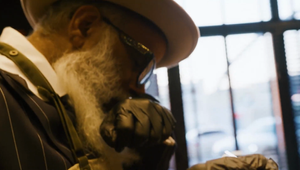
5 Minutes with… Nishant Shah

Having worked across Mumbai, Tokyo and Amsterdam, Nishant Shah has made a return to Dubai to assume the role of executive creative director at Serviceplan Middle East, where he’s keen to show how and why “the language of the advertising business is largely the same everywhere.”
Starting out as a production assistant after gaining his MBA in marketing, it was Mumbai where his journey started. Discovering his need to be a “compulsive storyteller” combined with his serial optimism, the work Nishant creates champions the notion of letting ideas run free and seeing where it goes.
His most recent role, prior to this one saw him create campaigns at Publicis Groupe Tokyo, and throughout his career, Nishant has worked across JWT, MullenLowe and 60LayersofCake creating work for Unilever, Nike, Red Bull and INFINITI, to name a few. Now, he’s excited to return to the UAE and create ever more compelling work for the Dubai arm of the Serviceplan agency.
Sharing his journey into the realm of advertising, many childhood dabbles into hobbies and wanderlust which has taken him around the world, Nishant speaks to LBB’s Nisna Mahtani.
LBB> What does creativity mean to you and when did you first realise that you wanted to be a creative?
Nishant> Let’s first acknowledge the fact that creativity isn’t a prize reserved for a few with a lateral bend of mind. It’s everywhere and in all of us. It’s primal. Across species, even. We are constantly creating – to survive, to solve, to communicate, to propagate – but mostly to draw out a favourable reaction to a certain need state. Perhaps why in the anagram-creation and reaction – there is room for one restless character who never settles for status-quo but seeks more.
I was that one character in a family of over-achieving, finance folk. It’s the same family whom I’m grateful for, who saw the method in my perpetual madness. I was constantly telling stories, even making my own up – all to draw a reaction. To make my mother laugh, to defer my dad’s wrath, to make friends. And before I knew it, I found a way to get paid for it.
LBB> Did your childhood hobbies or interests give any indication of the industry you would end up in? What were some of your interests growing up?
Nishant> My mother was a serial hobbyist. Every summer break, she lived out her interests vicariously through her children; just as every Asian parent does. She would sign us up for workshops, invariably in the arts – pottery, painting, toy making, dance, and even crochet. Sometimes it did feel like an imposition, but in hindsight, she handed down the most important lesson – being curious and trying new things. She was also the enterprising kind, always up to a new business idea. I remember making a poster for her small business using Microsoft Paint and Word Art. She wasn’t an easy client either, and budgets always shrank closer to production. But you can say, that was my very real portfolio school in the arts and commerce.
LBB> You’ve worked at advertising agencies around the world in cities such as Mumbai, Tokyo, Amsterdam and even Dubai, where you now return to. How has your global experience impacted your creativity, if at all?
Nishant> Creativity is subject to a lot of relativity. And often culture is what contextualises it. We’re able to appreciate the work more when we understand the cultural ingredient better. More often than not, the most successful campaigns play with these ideological fault lines to create work that cuts across time zones. Make no mistake, this is a realisation that I have now. My reason for exploring other markets was largely on a whim and some wanderlust.
Every time I moved cities, the first thing I noticed was the differences. Before long, the similarities surfaced – and that became my playing field. I’ve also realised the language of the advertising business is largely the same everywhere, but the creative grammar changes. Today, to be a global creative, it isn’t enough to see the work that wins at award shows, but to look at the local work that is far more honest and culturally nuanced. I call it Gonzo Advertising. To paraphrase Hunter S. Thompson [founder of Gonzo Journalism], “Walk tall, kick ass, learn to speak Arabic, love French music, and never forget you come from a long line of truth seekers, lovers and warriors.”
LBB> Where do you find inspiration for your leadership style and what kind of leader are you?
Nishant> Leadership to me is exercising trust and detachment, in equal parts. Trust the process, and be detached from the outcome. Trust the team to drive, and stay detached from how they get there. Trust the client's instinct, and keep detached from the all-pervasive data biases. And most importantly, trust common sense, and detach yourself from the jargon-ry.
LBB> How do you get the most out of your team on a day-to-day basis?
Nishant> It all comes down to ownership. The more ownership one feels towards the culture, the people, the process, or even their own ideas – the more they will bring to the party. But the thing about ownership is, it cannot be taught. So for the most part, all I do is show up, share my honest thoughts without overwriting their own, and remind them to have fun along the way. Parenthesis: This is true of most days. Some days, we don’t want to see each other. And that’s just how we keep it real.
LBB> What are some pieces of work you’re particularly proud of and can you tell us a little bit about the processes behind them?
Nishant> At my last agency - Publicis Groupe Japan – we launched the INFINITI QX60, a car designed and engineered by women, Pave It Forward was an initiative to create an inclusive driving experience. It was inspired by a simple observation – “Over 75% of the roads in the world are named after men.” This inherently gendered nature of the roads we drive on presents a biased view of women’s contribution to society. We needed to correct the narrative. We went beyond changing the names of the streets, by intercepting the entire navigation experience on Waze to spotlight women who pave the way forward, in every street named after men.
This one is special for more reasons than one. Besides it being a brave brand effort in the divisive times we live in, it helped us recognise the power of data. The most gratifying part is of course the process of bringing this to life. The research, the data collection, the storytelling, the digital integration, the deployment and the end-user experience – every single part of this process was handmade without the use of data banks, repositories or white papers. That level of commitment and passion can only come from a team that wants to make this happen for the right reasons. Something that we often forget in the deluded world of awards, rankings and transient glory.
LBB> Having worked in the Middle East before, what about the region and the UAE in particular is conducive to creativity and attracts international talent?
Nishant> The Middle East has to be one of the most fascinating coming-of-age stories. I can say that because I’ve seen this region mature over time. Creativity and the industrious spirit of the leadership here is the foreword to the region’s success story. Today, the UAE is its own brand. It is no longer that little boat reliant on the trade winds to fuel its course forward. This intentional shift from ‘reliance’ to ‘resilience’ attracts a certain breed of talent. One that is ambitious, self-reliant and harbours the creative hustle. No matter where you’re from, the culture you represent, the things you’ve achieved – the UAE invites you to a new start. No baggage. But for the 30kgs Emirates Airlines allows you to check-in.
There are many cultures that call the UAE home. But there is one that binds them all - the culture of absolute meritocracy. If you have the fight and fair play, this is the ring for you.
LBB> What is the most rewarding part of the creative process for you?
Nishant> Storytelling. Not the film, not the script, but in every part of the agency experience. The office chatter, the presentation theatre, the post-presentation rant, the production brief, the case study – heck, even this interview. Stories make everything better. I believe we’re creative only because we’re conversationalists first. I find it deeply upsetting when I see creative teams, screen-bound and tabs-tied. There is nothing more urgent than the story waiting to be shared.
LBB> How do you know when a piece of work has been completed? Is it a gut feeling, a deadline or something else that dictates your work?
Nishant> The thing is – the work is never complete. There is always that impending feeling of ‘it could’ve been better,’ and it often stays long after the work is out in the world.
Of course, there is the deadline, the gut feeling – but a whole lot of ‘confirmation bias’ that creatives use as a crutch, to be able to move on to the next thing.
LBB> What’s one piece of advice you’d encourage every creative person to heed?
Nishant> Find your unique voice and express yourself freely. Don’t auto-correct your thoughts. Don’t live out someone else’s dream. Scale your own mountain. Write your own quotes.















